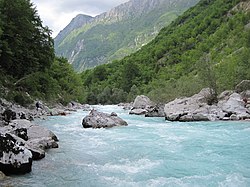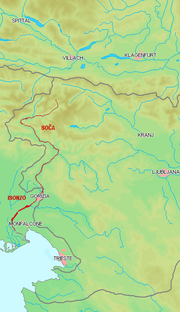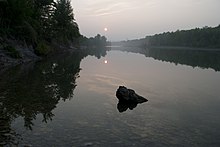Soča
| Soča/Isonzo | |
|---|---|
 The Soča near Bovec | |
| Location | |
| Country | Slovenia, Italy |
| Physical characteristics | |
| Source | |
| • location | Julian Alps, west of Triglav |
| • elevation | 876 m (2,874 ft) [1] |
| Mouth | |
• location | Adriatic Sea, near Monfalcone |
| Length | 138 km (86 mi) [1] |
| Basin size | 3,400 km2 (1,300 sq mi)[2] |
| Discharge | |
| • average | 172 m3/s (6,100 cu ft/s)[2] |
The Soča (pronounced [ˈsoːtʃa] in Slovene) or Isonzo (pronounced [iˈzontso] in Italian; other names Friulian: Lusinç, German: Sontig, Latin: Aesontius or Isontius[3]) is a 138-kilometre (86 mi) long river that flows through western Slovenia (96 kilometres or 60 miles) and northeastern Italy (43 kilometres or 27 miles).[1]
An Alpine river in character, its source lies in the Trenta Valley in the Julian Alps in northwestern Slovenia, at an elevation of 876 metres (2,874 ft).[1] The river runs past the towns of Bovec, Kobarid, Tolmin, Kanal ob Soči, Nova Gorica (where it is crossed by the Solkan Bridge), and Gorizia, entering the Adriatic Sea close to the town of Monfalcone. It has a nival-pluvial regime in its upper course and pluvial-nival in its lower course.[4]
Prior to the First World War, the river ran parallel to the border between Kingdom of Italy and the Austro-Hungarian Empire. During World War I, it was the scene of bitter fighting between the two countries, culminating in the Battle of Caporetto in 1917.
Name[]
The river was recorded in antiquity as Aesontius, Sontius, and Isontius. Later attestations include super Sontium (in 507–11), a flumine Isontio (1028), in Lisonçum (1261), an die Ysnicz (1401), and an der Snicz (ca. 1440). The Slovene name Soča is derived from the form *Sǫťa, which was borrowed from Latin (and Romance) Sontius. In turn, this is probably based on the substrate name *Aisontia, presumably derived from the PIE root *Hei̯s- 'swift, rushing', referring to a quickly moving river. Another possible origin is the pre-Romance root *ai̯s- 'water, river'.[5]
Major changes in the watershed[]

The present course of the river is the result of several dramatic changes that occurred during the past 2,000 years. According to the Roman historian Strabo, the river named Aesontius, which in Roman times flowed past Aquileia to the Adriatic Sea, was essentially the Natisone and Torre river system.[6]
In 585, a landslide cut off the upper part of the Natisone riverbed, causing its avulsion and subsequent stream capture by the Bontius River. The original subterranean discharge of the Bontius into the Timavo became obstructed, and another avulsion returned the new watercourse into the bed of the lower Natisone.
During the next centuries the estuary of this new river—the Soča—moved eastward until it captured the short coastal river Sdobba, through which the Isonzo now discharges into the Adriatic Sea. The former estuary (of the Aesontius, and the early Isonzo) in the newly formed lagoon of Grado became an independent coastal rivulet.[7]
Attractions[]
Due to its emerald-green water, the river is marketed as "The Emerald Beauty." It is said to be one of the rare rivers in the world that retain such a colour throughout their length.[8] Giuseppe Ungaretti, one of the greatest Italian poets, describes the Isonzo in the poem "The Rivers."
The river inspired the poet Simon Gregorčič to write his best-known poem Soči (), one of the masterpieces of Slovene poetry. This region served as a location for the 2008 Disney film Chronicles of Narnia: Prince Caspian.[9]
The river is also well known for the marble trout (Salmo marmoratus); this species is native to rivers of the northern Adriatic basin, and it lives in the upper course of the river. This species is endangered due to the introduction of other non-indigenous trout species sometime between World War I and World War II.[10]
Significance in World War I[]


The valley was the stage of major military operations including the twelve battles of the Isonzo on the Italian front in World War I between May 1915 and November 1917, in which over half million Austro-Hungarian and Italian soldiers lost their lives.[11][12]
The Isonzo campaign comprised the following battles:
- First Battle of the Isonzo: 23 June – 7 July 1915
- Second Battle of the Isonzo: 18 July – 3 August 1915
- Third Battle of the Isonzo : 18 October – 3 November 1915
- Fourth Battle of the Isonzo: 10 November – 2 December 1915
- Fifth Battle of the Isonzo: 9–17 March 1916
- Sixth Battle of the Isonzo: 6–17 August 1916
- Seventh Battle of the Isonzo: 14–17 September 1916
- Eighth Battle of the Isonzo: 10–12 October 1916
- Ninth Battle of the Isonzo: 1–4 November 1916
- Tenth Battle of the Isonzo: 12 May – 8 June 1917
- Eleventh Battle of the Isonzo: 19 August – 12 September 1917
- Twelfth Battle of the Isonzo: 24 October – 7 November 1917, also known as the Battle of Caporetto
See also[]
- Karst topography
- Battles of the Isonzo
- Gorizia
- Goriška
References[]
- ^ Jump up to: a b c d Rivers, longer than 25 km, and their catchment areas, Statistical Office of the Republic of Slovenia
- ^ Jump up to: a b "Drainage Basin of the Mediterranean Sea" (PDF). Second Assessment of Transboundary Rivers, Lakes and Groundwaters. United Nations Economic Commission for Europe. August 2011. p. 159. ISBN 978-92-1-117052-8.
- ^ Richard J.A. Talbert, ed. (2000). Barrington Atlas of the Greek and Roman World: Map-By-Map Directory. I. Princeton, NJ and Oxford, UK: Princeton University Press. p. 273. ISBN 0691049459.
- ^ Brečko Grubar, Valentina; Kovačič, Gregor (2010). "Pokrajinskoekološka oznaka jadranskega povodja v Sloveniji s poudarkom na kakovosti vodnih virov" [Landscape Ecological Characterization of the Adriatic Sea Basin in Slovenia with an Emphasis on Water Resource Quality]. Annales. Series historia et sociologia (in Slovenian). 20 (1): 153–168.
- ^ Snoj, Marko (2009). Etimološki slovar slovenskih zemljepisnih imen. Ljubljana: Modrijan. pp. 386–387.
- ^ Strabo, Geography, Vol. V, Chapter 1
- ^ Brockhaus' Konversations-Lexikon. 14th ed., Leipzig, Berlin and Vienna 1894; Vol. 9, p. 727.
- ^ Soca River Whitewater Rafting
- ^ "Filming locations for The Chronicles of Narnia: Prince Caspian". IMDb.com.
- ^ "Marble trout (Salmo marmoratus)". Balkan Trout Restoration Group. Retrieved 2009-05-29.
- ^ FirstWorldWar.Com The Battles of the Isonzo, 1915-17.
- ^ See also John R. Schindler, Isonzo: The Forgotten Sacrifice of the Great War (2001). ISBN 978-0275972042.
External links[]
| Wikimedia Commons has media related to Soča. |
- Condition of Soča at Log Čezsoški and Solkan - graphs, in the following order, of water level, flow and temperature data for the past 30 days (taken in Log Čezsoški and Solkan by ARSO)
- The Walks of Peace in the Soča Region Foundation. The Foundation preserves, restores and presents the historical and cultural heritage of the First World War in the area of the Isonzo Front for the study, tourist and educational purposes. (in Slovene, English, Italian, and German)
- Galleries of Soca river in kayak
- Awarded "EDEN - European Destinations of Excellence" non traditional tourist destination 2008
Coordinates: 45°59′40″N 13°38′29″E / 45.99444°N 13.64139°E
- Soča
- Soča basin
- Rivers of Italy
- Rivers of the Province of Gorizia
- Rivers of the Slovene Littoral
- Waterways of Italy
- International rivers of Europe
- Rivers of the Julian Alps
- Braided rivers in Europe

